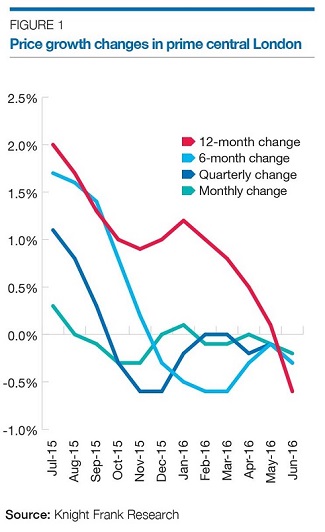Average prices across prime central London fell in June by -0.2%, the weakest monthly result since November 2014. June’s result pushed annual price growth to -0.6%.
The index data for June largely covers the period leading up to the UK’s EU referendum. Weaker price growth, together with rising economic and market uncertainty surrounding the European vote, has prompted vendors to reduce asking prices over recent months.
This more realistic approach has resulted in an uptick in activity – most notably in the immediate aftermath of the referendum result. Following the referendum, in final week of June, the number of transactions across prime London was 38% higher than the prior week and 29% higher than the final week of May.

This positive story has been widely reported, but what has often been missed is the weakness of sales prior to the vote, which has flattered more recent sales data. While the reduction in asking prices has boosted recent activity, it would be wrong to ignore market risks. An initial reading of post-referendum data on new-buyer registrations and viewings reveals both have slipped back slightly compared to the same period a month ago – although it is still very early to draw firm conclusions.
Looking ahead, political uncertainty in the UK will undoubtedly weigh on sentiment, and will be likely to last until at least the heads of terms of the new relationship between the UK and the EU are agreed. A reduction in political risk, should allow mitigating factors to kick in and support the London market.
A cut in the UK base rate, while unlikely to fully translate into lower mortgage rates, would be a positive for the property market. Similarly, recent and proposed rate cuts in markets like India and China and record low government bond yields make property a more attractive investment by comparison.
The current residential yield in prime central London is 3.1% versus 0.9% on a ten-year UK government bond. Finally, the recent weakening of Sterling is having a positive impact on relative affordability for international buyers in the London market – for a Hong Kong buyer effective pricing in prime central London is 21% lower than it was two years ago.
Looking at the market by price band, we see a more nuanced story. On a quarterly basis, while the whole market saw prices fall -0.3%, prices for sub-£1m properties rose on average by 0.4%.
This outperformance of lower price points within the prime London market is reflected by local sub-market performance. Prices in The City & Fringe, Islington and South Bank rose on average by 0.8% to 1.5% in the quarter to the end of June. Positive growth wasn’t confined to the eastern part of central London, South Kensington and Marylebone saw quarterly growth of 0.9% and 0.4% respectively.
Furthermore, new-buyer registration volumes rose in the £2m-£5m and the £5m-£10m markets (9% and 8% respectively) over the past year. These markets have been the weakest performers for two years in terms of price growth and renewed interest here may point to some opportunistic buys in the next few months.











